Lab 1 Caesar Cipher (Old)
This lab was replaced due to a restructuring in the first couple weeks. The spec is preserved here.
IntelliJ Test
To test if everything is working correctly, run the CaesarCipher class, as
shown below:
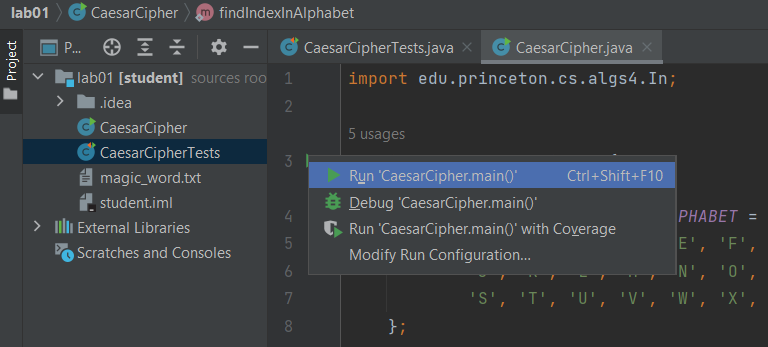
You should see a console pop up, prompting you to "Type text to encrypt":
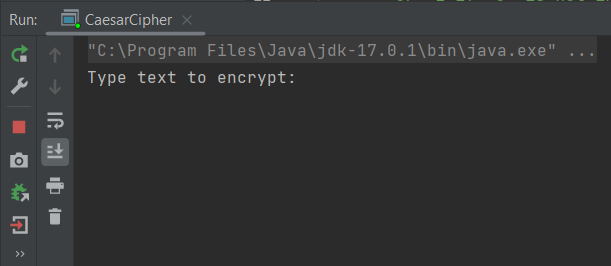
You can click the red square to terminate the program.
Programming Exercise: CaesarCipher
This exercise relies on some material from HW 0. If you have not written Java before, we strongly recommend reading HW 0 before this part. We encourage you to ask for help on HW 0 concepts during lab.
Background
A cipher is an algorithm for encrypting or decrypting text. Generally, we call the unencrypted text "plain text" and encrypted version "cipher text".
Here is an example of text that uses a Caesar cipher (which you will implement in this lab):
| Plain Text | Shift | Cipher Text |
|---|---|---|
java is fun | +8 | sjej rb odw |
Notably, the original text is readable, but the encrypted version is not.
A Caesar cipher is computed by "shifting" each letter of the text some number of spaces forward in the English alphabet, wrapping around at the end, as though it was written in a circle. For example, the following "ring" represents a mapping for a Caesar cipher with each outside letter shifted forward by 4 to get the inside letter.
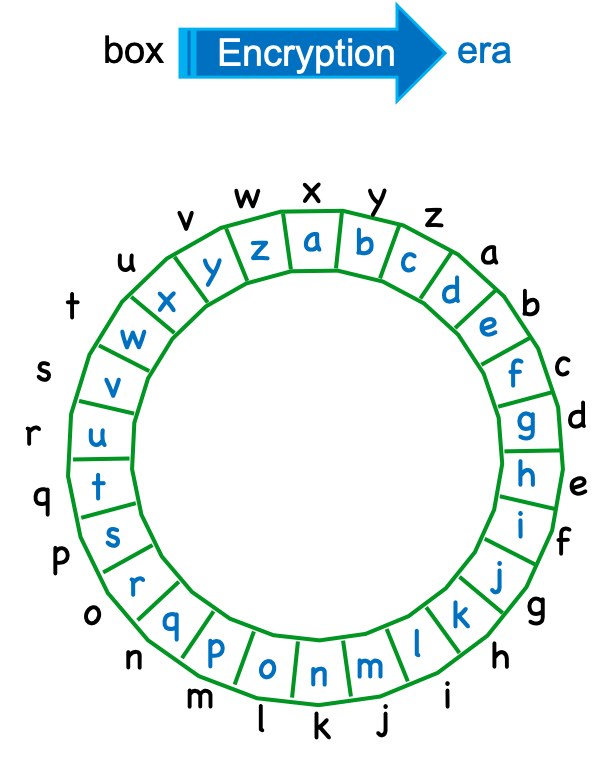 {: style="max-height: 325;" }
{: style="max-height: 325;" }
In this lab, you'll be editing the CaesarCipher.java file, which has
empty methods for you to fill in. We will provide you Python code for these
methods. You might find HW 0, which compares Python and java syntax, to be
helpful. We recommend completing HW 0 before working on this part of the lab.
Our goal is to be able to take in a piece of text, the number of letters to
shift forward by, and output the encrypted text. We've provided a small main
method that will take input from the console. You don't have to understand how
it works, however.
In Python, there is only one way to represent strings of length one; however,
in Java, there are two. First, we can represent them as a String, similar to
Python str. Second, there is a separate type called char. The reason for
this distinction is that, because we require types in Java, it is useful to be
able to specify that we’re working with a single letter. Unlike in Python,
Strings in Java must use double quotes (\") and chars must use single
quotes (').
Methods to Implement
The first function you should implement is findIndexInAlphabet.
public static int findIndexInAlphabet(char c)
You should loop through the valid indices of ALPHABET and return the index
equal to the input character c if one exists. If no such index exists, you
should return -1.
In Python, this method might approximately look like:
def findIndexInAlphabet(c):
for i in range(len(ALPHABET)):
if ALPHABET[i] == c:
return i
return -1
In Python, you can't have two methods named the same thing. However, in Java,
we can! This is called method overloading, and works because the types of
the arguments are different. Next, you will implement two versions of the
rotate method: one for if we want to rotate a char (character), then another
for rotating a String.
public static int rotate(char c, int amount)
Convert the input character into a number. Then, add the rotation amount to
that number, making sure to wrap the number around so it is between 0 and
25, the valid indices for the alphabet. Then, convert it back to a character.
If the character doesn't appear in the alphabet, return the character directly.
In Python, this method would approximately look like:
def rot(c, amount):
idx = findIndexInAlphabet(c)
if idx == -1:
return c
newIdx = (idx + amount) % len(ALPHABET)
return ALPHABET[newIdx]
The String version is the one that we call in main.
public static int rotate(String line, int amount)
Rotate each character by the rotation amount, and return a new String made
up of the rotated characters.
In Python, this method would approximately look like:
def rot(line, amount):
output = ""
for c in line:
output += rot(c, n)
return output
Testing Your Code
While we could run the CaesarCipher file again and again to check that our
code works correctly, it would take a lot of time to type into the program each
time, and manually check that the output is correct. Instead, we use tests.
Open CaesarCipherTests.java, and click the green triangle next to the
public class CaesarCipherTests:
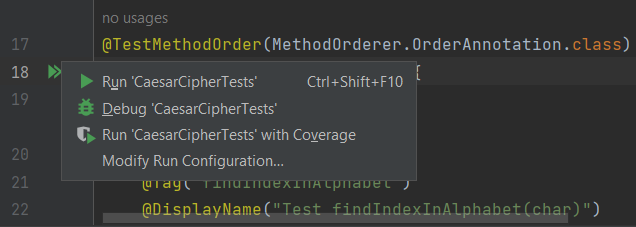
This will run the tests that we have provided in this assignment. If you have correctly implemented the functions, all the tests will pass with a green checkmark:
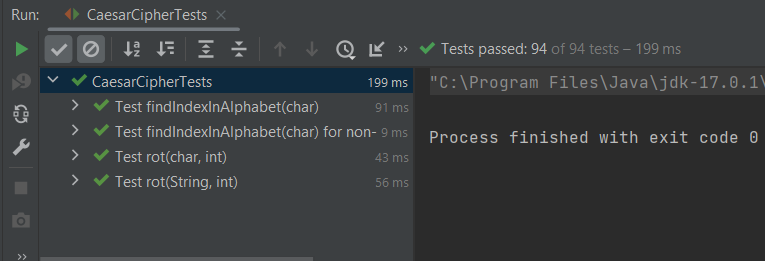
If you don't pass some tests, you'll see either a red exclamation point or a
yellow x:

To debug, click the dropdowns to see the output from a specific failing test. Then, read the error to figure out why the bug might have occurred!